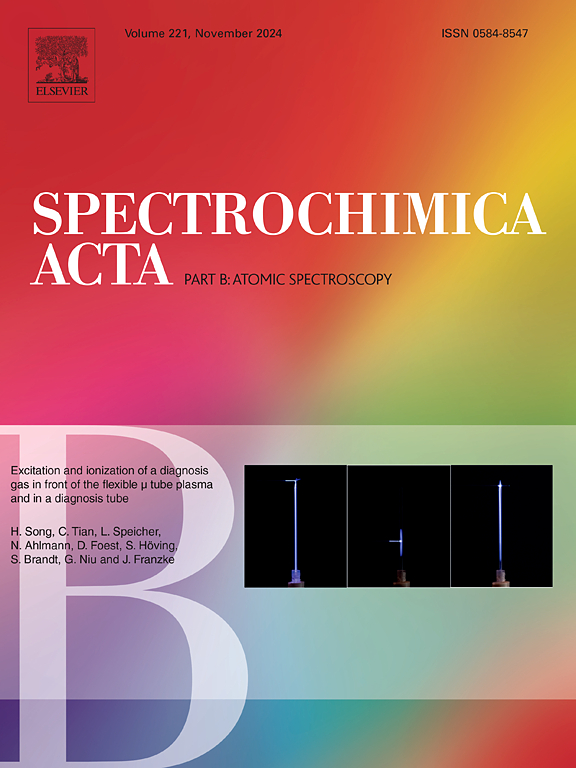Comparison of methodological strategies to determine Sr concentrations in Ca-rich matrices
IF 3.2
2区 化学
Q1 SPECTROSCOPY
引用次数: 0
Abstract
Over the last few decades, there has been a steady increase in available analytical techniques and protocols in geochemical and bioarchaeological research to determine elemental concentrations. However, the validity of acquired results greatly depends on multiple factors, such as the sample matrix, pre-treatment protocols, the used analytical technique, appropriate standardization, calibration strategies, and the adequacy of the selected reference materials. Samples such as excavated skeletal remains prove to be particularly challenging to characterize using mass spectrometric techniques, as these require extensive pre-treatment procedures, and display a phosphate-rich, calcium (Ca)-heavy matrix, leading to potential interference effects upon ionization within the plasma. In this study, strontium (Sr) concentration analyses of 98 calcined archaeological bone samples are determined relying on HR-ICP-MS and ICP-QQQ-MS, using well-established concentration determination protocols. The applied procedures and HR-ICP-MS and ICP-QQQ-MS measurement routines are considered fully suited for the concentration determination of Sr in a Ca-heavy matrix, provided that Ca-normalizations of the acquired Sr data are carried out. It was found that the Sr concentration data from MC-ICP-MS correlate well with the data obtained relying on HR-ICP-MS and ICP-QQQ-MS, implying that MC-ICP-MS is also suited for Sr concentration determination in given sample matrices with the described procedures, saving both resources and time. The acquired data is also fully comparable with HR-ICP-MS and ICP-QQQ-MS data for Sr-isolated solutions, where the sample matrix was removed. The findings of this study, tested on cremated bone material, open up novel method development perspectives on other Ca-heavy samples, such as shells, speleothems, phosphate minerals and limestones.

测定富钙基质中锶浓度的方法学策略比较
在过去的几十年里,在地球化学和生物考古研究中,确定元素浓度的可用分析技术和方案稳步增加。然而,所获得结果的有效性很大程度上取决于多种因素,如样品基质、预处理方案、使用的分析技术、适当的标准化、校准策略以及所选标准物质的充分性。事实证明,使用质谱技术对挖掘出的骨骼遗骸等样品进行表征尤其具有挑战性,因为这些样品需要大量的预处理程序,并且显示出富含磷酸盐、重钙(Ca)的基质,导致对等离子体内电离的潜在干扰效应。在本研究中,利用成熟的浓度测定方案,利用HR-ICP-MS和ICP-QQQ-MS对98个煅烧考古骨样品进行了锶(Sr)浓度分析。应用程序以及HR-ICP-MS和ICP-QQQ-MS测量程序被认为完全适合于重钙基质中Sr的浓度测定,前提是对获得的Sr数据进行ca归一化处理。结果表明,MC-ICP-MS测定的Sr浓度与HR-ICP-MS和ICP-QQQ-MS测定的Sr浓度具有良好的相关性,表明MC-ICP-MS也适用于给定样品基质中Sr浓度的测定,节省了资源和时间。所获得的数据也与sr分离溶液的HR-ICP-MS和ICP-QQQ-MS数据完全可比,其中样品矩阵被去除。这项研究的结果,在火化骨材料上进行了测试,为其他重钙样品(如贝壳、洞穴、磷矿物和石灰石)开辟了新的方法开发前景。
本文章由计算机程序翻译,如有差异,请以英文原文为准。
求助全文
约1分钟内获得全文
求助全文
来源期刊
CiteScore
6.10
自引率
12.10%
发文量
173
审稿时长
81 days
期刊介绍:
Spectrochimica Acta Part B: Atomic Spectroscopy, is intended for the rapid publication of both original work and reviews in the following fields:
Atomic Emission (AES), Atomic Absorption (AAS) and Atomic Fluorescence (AFS) spectroscopy;
Mass Spectrometry (MS) for inorganic analysis covering Spark Source (SS-MS), Inductively Coupled Plasma (ICP-MS), Glow Discharge (GD-MS), and Secondary Ion Mass Spectrometry (SIMS).
Laser induced atomic spectroscopy for inorganic analysis, including non-linear optical laser spectroscopy, covering Laser Enhanced Ionization (LEI), Laser Induced Fluorescence (LIF), Resonance Ionization Spectroscopy (RIS) and Resonance Ionization Mass Spectrometry (RIMS); Laser Induced Breakdown Spectroscopy (LIBS); Cavity Ringdown Spectroscopy (CRDS), Laser Ablation Inductively Coupled Plasma Atomic Emission Spectroscopy (LA-ICP-AES) and Laser Ablation Inductively Coupled Plasma Mass Spectrometry (LA-ICP-MS).
X-ray spectrometry, X-ray Optics and Microanalysis, including X-ray fluorescence spectrometry (XRF) and related techniques, in particular Total-reflection X-ray Fluorescence Spectrometry (TXRF), and Synchrotron Radiation-excited Total reflection XRF (SR-TXRF).
Manuscripts dealing with (i) fundamentals, (ii) methodology development, (iii)instrumentation, and (iv) applications, can be submitted for publication.

 求助内容:
求助内容: 应助结果提醒方式:
应助结果提醒方式:


